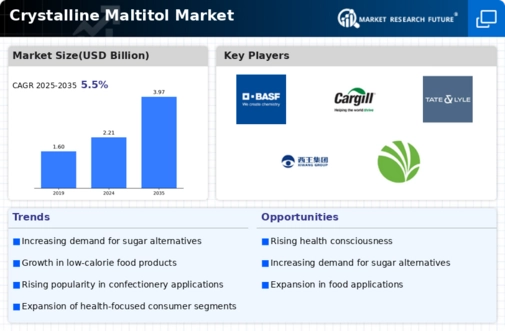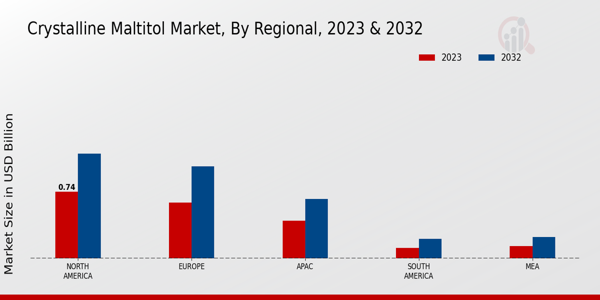Market Trends and Projections
The Global Crystalline Maltitol Market Industry is characterized by various trends and projections that highlight its growth potential. The market is expected to reach 3.97 USD Billion by 2035, indicating a strong upward trajectory. Additionally, the compound annual growth rate of 5.46% from 2025 to 2035 suggests a sustained interest in maltitol as a sugar alternative. These trends are influenced by factors such as increasing health awareness, regulatory support, and innovations in food technology. The convergence of these elements positions the market favorably for future expansion, reflecting a dynamic landscape that is responsive to consumer needs.
Innovations in Food Technology
Innovations in food technology are playing a pivotal role in shaping the Global Crystalline Maltitol Market Industry. Advances in processing techniques and formulation strategies have enhanced the functionality of maltitol, making it a preferred choice for manufacturers. These innovations enable better texture, taste, and stability in food products, which are crucial for consumer acceptance. As a result, the market is likely to experience a compound annual growth rate of 5.46% from 2025 to 2035. This growth is indicative of the industry's adaptability and responsiveness to evolving consumer preferences, further solidifying maltitol's position in the market.
Growing Awareness of Health Benefits
Growing awareness of the health benefits associated with maltitol is a key driver for the Global Crystalline Maltitol Market Industry. As consumers become more informed about the advantages of low-calorie sweeteners, including their potential to aid in weight management and dental health, the demand for maltitol is likely to increase. This heightened awareness is reflected in the rising number of products marketed as sugar-free or low-calorie, which prominently feature maltitol as a key ingredient. The industry's growth trajectory appears promising, with projections indicating a market value of 2.21 USD Billion in 2024, suggesting a robust future fueled by informed consumer choices.
Rising Demand for Sugar Alternatives
The Global Crystalline Maltitol Market Industry is witnessing an upsurge in demand for sugar alternatives, driven by increasing health consciousness among consumers. As individuals become more aware of the adverse effects of sugar on health, the preference for low-calorie sweeteners like maltitol is growing. This trend is particularly evident in the food and beverage sector, where manufacturers are reformulating products to reduce sugar content. In 2024, the market is projected to reach 2.21 USD Billion, reflecting a significant shift towards healthier options. This demand is expected to sustain growth, as consumers increasingly seek products that align with their dietary preferences.
Expansion in the Confectionery Sector
The Global Crystalline Maltitol Market Industry is significantly influenced by the expansion of the confectionery sector. As confectionery manufacturers seek to cater to health-conscious consumers, maltitol serves as an effective sugar substitute that provides sweetness without the associated calories. This trend is particularly pronounced in sugar-free and reduced-calorie products, which are gaining traction in various markets. The industry's growth is projected to continue, with the market expected to reach 3.97 USD Billion by 2035. The increasing availability of maltitol-based products in retail outlets further supports this expansion, indicating a robust future for the industry.
Regulatory Support for Low-Calorie Sweeteners
The Global Crystalline Maltitol Market Industry benefits from regulatory support for low-calorie sweeteners, which is fostering a conducive environment for market growth. Governments worldwide are increasingly recognizing the need to address rising obesity rates and related health issues. Consequently, regulations that promote the use of sugar substitutes are being implemented. This support not only encourages manufacturers to innovate but also reassures consumers about the safety and efficacy of products containing maltitol. As the regulatory landscape evolves, it is anticipated that the market will continue to expand, driven by both consumer demand and supportive policies.







